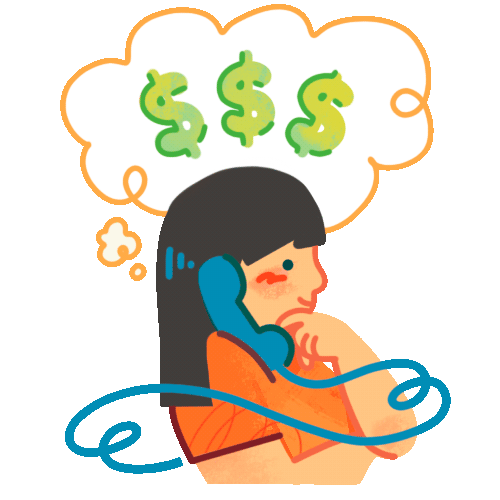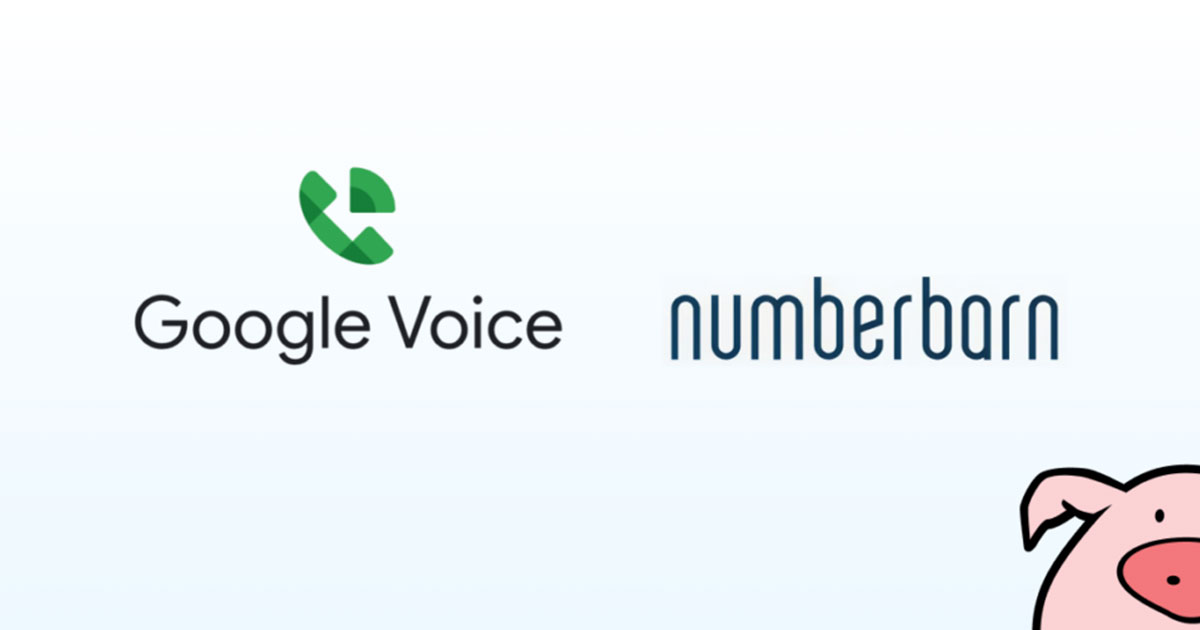So you want to get a phone number, but you don’t really know how. And how much does a phone number cost, anyway?
Well, how to get a phone number and how much it costs will generally hinge on three main factors:
- Phone type: Mobile, Landline, Toll-Free, VoIP
- Phone number capabilities: Regular voice calls, SMS text messaging, online features, and more
- Country: Where you live and where you’re calling
First, to have a phone number, whether it’s active or “parked” (saved for later), the phone number has to have a phone provider or carrier to host or support it. Each company will likely have its own fees, plans or rates, with a few exceptions. Your phone plan, however structured, will hinge on one or multiple of these variables, whether it’s minute-based, a virtual line, or of course, a “regular” cell phone plan.
Table of contents
- Sign up for a phone plan + phone from a major telephone provider
- Or get a phone plan through a MVNO (Mobile Virtual Network Operator)
- Choose a new/additional line to ‘Port’
- Buy a phone number online, then Port or Forward it
- Get an additional SIM card/second phone
Preface
“Mr. Watson, come here, I want to see you,” were the first words spoken into a phone. Since Alexander Graham Bell said that into his 1876 invention, phones have come a long way… but a lot has surprisingly stayed the same.
Why the history lesson? Well, because the way the Bell Telephone Company worked in the late 1800s still surprisingly dictates how we buy telephones and phone numbers today in 2025.
That’s because that same Bell Telephone Company would eventually become the “American Telephone and Telegraph Company” (or, you know, “AT&T”), which built up the telephone lines and operator centers across the country that started the concept of getting the best phone coverage, spurring a competition that’s still raging today. It’s the model that we generally still use when we think about buying phones and phone numbers.
#1. Sign up for a phone plan + phone from a major telephone provider
So you don’t have a phone carrier yet? Maybe you don’t even have a phone. That’s not a problem, if the major phone carriers have any say in it.
Here’s how to get a phone number in the most traditional of ways.
The 3 Major U.S. Phone Providers
| Average monthly cost of phone plan |
|---|
| AT&T: $175/month |
| Verizon: $160/month |
| T-Mobile: $142/month |
| Total Average: $159/month* |
*- WhistleOut report December 2024
They’re the three major phone companies for a reason: AT&T, Verizon, and T-Mobile cover the vast majority of the United States, as well as much of Canada and Latin America; they collectively own most of the cell phone towers in the country.
Check your coverage areas here:
- https://www.att.com/maps/wireless-coverage.html
- https://www.verizon.com/coverage-map
- https://www.t-mobile.com/coverage/coverage-map
Typically, the three major phone companies will try to sell you a cell phone (and a landline, and internet connection, and…), complete with your very own telephone line/number. The hardware is why their monthly average is so much higher than other options out there.
If you already have a paid off cell phone device, a monthly bill from one of the major telephone companies is generally closer to $45-65 a month, depending on a wide variety of factors (location, being the biggest one).
Adding additional lines to your “big 3” phone plan tends to cost somewhere around $15-35 per each additional line, though cost will definitely vary. (Special “family plan” deals will likely be aggressively pitched to you, which might be a good deal for you, or could just be a way to get you to spend more.)
The number of ways you can build a phone plan with the three major phone lines are almost endless. (We aren’t here to tell you what the best phone plans of 2025, there are other resources for that.)
The good news is that whatever you need, you’re likely to find something to build a plan around, whether it be minutes-based, unlimited calls, data plans, a plan focused on free texting, pre-paying minutes or for an entire year at once instead of monthly, “buy one get one,” deferred paying altogether until later, or an additional payment plan to help you get an ultra-fancy iPhone or Android in the process.
Check with your local T-Mobile/Verizon/AT&T branch stores near you to see what sorts of deals are available to you, or go to their websites and see what plans are available to you. (Though keep in mind that where you are located might dictate what sort of new phone line deals you may be able to get!)
#2. Get a phone plan through a MVNO (Mobile Virtual Network Operator)
- Visible (owned by Verizon)
- Cricket Wireless (owned by AT&T)
- Metro (owned by T-Mobile)
- Mint Mobile (owned by T-Mobile)
- Boost (owned by T-Mobile)
- XFinity Mobile (owned by Comcast)
- Consumer Cellular
Average cost: ~$30 a month per line*
*WhistleOut report December 2024
In a big world of cell phone companies dominated by virtual monopolies, there exist smaller, leaner alternatives growing in popularity, though they’re quite popular already — we’re looking at you, endless stream of Ryan Reynolds ads for Mint Mobile. These companies collectively make up almost half of the phone marketplace.
“MVNO’s,” or “Mobile Virtual Network Operators,” are smaller phone providers with cheaper prices.
These companies generally don’t own any cell phone towers, but instead rent access to portions of the towers that are owned by “the big three” (i.e., Verizon, AT&T, and T-Mobile). And because they don’t upkeep that giant system of towers (plus advertising, dealing with as many shareholders, etc.), they are able to charge less for access to a phone line, often with no contracts involved.

Yes, you can definitely still pay payment plans for a cell phone through a MVNO company, but MVNO plans generally hover around $25-50+ a month, and even with an added payment plan for a phone, they tend to be cheaper than the big three.
The trade-off, however, is that your ability to get satisfactory phone coverage with your MVNO plan is highly contingent on where you live; a Metro or Mint Mobile plan, for example, will only be as good as your proximity to 4G and 5G towers, and will likely have limited minutes and possibly limited texts as well.
4G and 5G coverage
Speaking of, it’s worth generally knowing what “4G” and “5G” mean! Without getting into their specific differences, these terms basically mean “4th generation” and “5th generation” of broadband telephone technology. In short, most coverage is still in “4G,” but slowly, more and more of the industry is migrating to “5G” coverage as towers are being built and plans are being built around their implementation.
Are MVNO companies different from the three major phone companies?
It’s worth noting that a lot of these smaller companies have actually been purchased by one of the three major telephone companies, despite being advertised and positioned as clever alternatives to their parent companies. Now you might be asking yourself, “Hey, if the same companies own all of the phone towers and purchase the competition in order to maintain the entire marketplace across all price points, how is the Federal Trade Commission okay with this?” Well, to that, I simply say…listen, do you want to get to the end of this article or not?
#3. Choose a new/additional line to ‘Port’
In this scenario, you already have some sort of a phone provider, but you just want another line. There are multiple ways to get a phone number when you already have a phone number through a provider, beginning with the most obvious way.
Simply add a line with your current phone provider
All of the three major phone carriers (and the dozens of MVNO smaller carriers) will likely have a simple way to add a line to your plan, whether it’s through your phone you already have, or through an additional phone. (Check their web pages for more details, including on if you will need an additional SIM card — more on that later.)
On average, new lines from a phone carrier typically will cost around $35+ per additional line, though this will depend on your overall package; sometimes there are deals, such as “buy one line get one free,” or other nifty multi-line family plan packages.
To begin adding a new line with one of the three major carriers:
Verizon
Tap the “Add a Line” tab in your “My Verizon” app, or contact Verizon directly:
- Phone: 800-837-4966
- Web: https://www.verizon.com/support/contact-us/
- Verizon “Second Number”: https://www.verizon.com/solutions-and-services/add-ons/mobile/second-number/
AT&T
You can add a second line with AT&T to your plan, but you will need a second device. Tap the “Add a Line” tab in your AT&T app, or contact AT&T directly:
- Phone: 800-288-2020
- Web: https://www.att.com/plans/add-a-line/
T-Mobile
You can add a second line with T-Mobile to your phone using their “DIGITS” program. Tap the “DIGITS” tab in your T-Mobile “T-Life” app, or contact T-Mobile directly:
- Phone: 1-800-937-8997
- Web: https://www.t-mobile.com/customers/device-add-a-line
- T-Mobile DIGITS: https://www.t-mobile.com/support/tutorials/device/app/ios/topic/digits-app/purchase-a-new-line
#4. Buy a phone number online, then ‘Port’ or Forward it
If you’re looking to add multiple numbers, you have a few options. Sometimes it’s much cheaper and easier to get a phone number through a third party and forward it to your current phone number and plan, or use a virtual number. This allows you to have multiple phone numbers, all routed to your current phone number and cell phone. You can get a few perks for doing it this way, too!
You can also consider purchasing a number and porting (or transfering) it entirely to another carrier or your current plan.
Virtual Numbers
Rather than pay for a potentially expensive “family plan” or add $35+ dollars to your monthly bill for possibly the same set of features you already have with your first line, you can get a new number elsewhere, then forward that new number to your current number or plan. (Or use it separately via an app, like with a VoIP number. We’ll get to that.)
Virtual numbers can allow you to have more than one phone number at the same time, or separate personal and professional calls if you need a business number, all while still continuing to use your same cell phone device without needing to purchase another phone.
Why do people get a number from a different company?
- It’s generally cheaper.
- You can potentially pick or personalize what your new digits will be (this is called a custom “vanity number”).
- Get additional features such as auto-attendant menus, caller ID tracking, online voicemail and text records, and more.
- It can be a toll-free number (e.g., “1-800”).
- You can purchase and add multiple numbers at a time.
Try NumberBarn
You can search various phone number marketplaces and find your ideal custom vanity number to own and then park, forward or port to the carrier of your choice. We’ll pause to speak for NumberBarn for a second (yup that’s us). After you purchase your phone number, parking and forwarding plans start at just a few bucks a month. (Phone numbers themselves start at just $5, but can cost a pretty penny for something like a phone number with repeating digits, or one that spells “INJURED”, etc.)
You can either port out your new number to another carrier, “park” it (like storing or saving a number), or use it actively with call forwarding, etc. For instance, maybe you found a personalized number that spells your name, just for fun, but you’re not sure what carrier you want to port it to.
You can park it with NumberBarn for just $2 a month until you decide if you want to use it, or forward calls to it over to your current number, or elsewhere. (NumberBarn is not a phone provider itself, but rather, works seamlessly with the phone provider you might already have.)
If you decide to keep a number with NumberBarn (note: you can also port most numbers into NumberBarn if you just want to save an old number), NumberBarn even has a web browser login and free mobile app that allows you to check who calls which of your multiple numbers, get tracked voice mails directly to your email, and much more.
Other virtual number providers with a smaller pool of numbers to choose from include services such as Ring Boost, Grasshopper, Burner, and more. Each provider offers their own unique set of features, so make sure to shop around and see who has exactly what you need.
Note: Most numbers you buy at places like NumberBarn are able to be ported, but in some circumstances (such as porting a landline to a mobile phone), there may be complications, incompatibilities, or longer port times. Always check with your preferred provider first to see if they will accept a specific number to port.
For the three major phone carriers, check the following pages to see if your chosen number can be ported:
- Verizon porting: https://www.verizon.com/switch-to-verizon/check-status
- AT&T porting: https://www.att.com/portstatus
- T-Mobile porting: https://www.t-mobile.com/support/account/transfer-your-phone-number
VoIP browser and app based numbers
Other VoIP (or “Voice over Internet Protocol”) services exist that allow you to get a serviceable number for use predominantly through (usually) a web app for free! (Well, sort of. We’ll explain.)
VoIP based phone numbers are hugely popular with businesses that use call centers, for example, as you can crop up a large amount of numbers without paying for dozens of individual phone lines. One of the largest examples of these types of services is, of course, Google Voice.
Typically, these types of additional numbers are free, though come with a lot of restrictions. For example, you do need a phone number already in order to set up a Google Voice number.
Google Voice in particular also only allows for calls and texts within the U.S., meaning you’ll have to “add credits” to be able to do anything internationally.
Like with all VoIP based phone calls, they are also reliant on a stable internet connection at all times (think: ZOOM call), which means it’s data dependent.

You can’t choose most of your phone numbers when you get a free Google Voice number, nor can you get a toll free number.
Also, most business features are paywalled, meaning you will need to pay money if you need things like Business Caller ID or HD sound. Google Voice also does not support RCS or iMessage text messaging.
And yes, you can port your Google Voice number to your phone carrier for $3 (this will make it a “linked number”), but once you do that, you can no longer use that number through Google Voice itself to make or receive calls/texts. Like porting any number to another carrier, that number will then be subject to the new carrier’s plans and fees.
Okay, deep breath. If literally all of that is not a deal breaker for you, a VoIP, app-based solution is definitely a great way to acquire another (albeit highly limited) phone number.
Other VoIP services include Dial Pad, ZOOM, Vonage, Ring Central, and OpenPhone.
#5. Get an additional SIM card/second phone
Maybe you need more than one number, and you want to be kind of fancy about it?
Well, good news! The other true-blue way to get a phone number is through multiple SIM (“Subscriber Identity Module”) cards for your phone that each are assigned a different number, as well as, you know, just buying multiple phones that each come serviced separately!
Why get multiple SIM cards/phones?
It’s most common when hopping between two countries where perhaps you might have a pre-paid number set up on one SIM card, then your “regular” phone number on the other SIM card.
Prepaid SIM cards are pretty similar to purchasing $20-$500+ gift cards that you can insert into your phone.
In some cases, some people go so far as to have two introductory phone plan rates from two different carriers, as opposed to adding lines to a single carrier. (Hey, you asked how to get a number, and we left no rock unturned!)
How do you do these things? Well, it depends on how many SIM card slots are available on your particular phone, as well as what your particular phone provider allows for, when it comes to hardware compatibility and service options. Check with your phone carrier to see what their SIM card requirements are for your particular plan and phone model. (This is where having either an iPhone, Android, or some secret third thing will likely matter.)
And yes, burner phones exist, though any service that offers you one isn’t going to do anything too much different than what we outlined above: get you a phone, keep the number they assign you, or port in your number of choice.
Burner phones typically cost around $25-50 a month, and are even available at major chain retailers, such as Target, Walmart, and Best Buy, among others.
Summary
So to sum it all up for you, there are several ways to get a new phone number, each with varying costs from free, to hundreds of dollars per month depending on what you’re looking for. You can use a:
- Major phone carrier – you pay for a monthly plan often with a contract, and they assign a phone number to you.
- Virtual number provider like NumberBarn, where you can purchase numbers starting at just $5 (or spend thousands of dollars if you’re looking for a “billboard” number). You can use the number in an app or your browser, or forward any calls to that number over to your existing phone number, using your current cell phone and plan you normally do.
- VoIP or app-based company like Google Voice, etc.
- Dual sim card cell phone, or a burner phone, but both will still require some kind of plan or phone carrier in order to send and receive calls.
Whatever route you pick, it’s great to have a birds eye view of all your options. And with ever-evolving technologies, we’re certain there will always be more options on the horizon.




